Y. Accounts Receivable Are Too High Overview Businesses are clearly in operation to sell products and services for money. Unfortunately, payments for those products and services aren't received immediately, due to The inability to invoice immediately The Customer's understandable unwillingness to pay immediately The inability to process payment immediately
The manifestation of this is that at any time a large sum of money is often outstanding, known as accounts receivable. Clearly the business would like to keep this at a minimum. Examples All businesses that sell products and services for remuneration. Measuring Performance Accounts Receivable (A/R) is measured in Days Sales Outstanding (DSO), which is basically just the average payment duration. It is also possible to measure A/R in dollar-daysthe amount of dollars outstanding for the amount of days (which represents the true cost to the business of the monies outstanding) because focus should be on both elements. DSO is in fact a better, more objective measure for the project because it is independent of the dollar value of sales made (we could reduce dollar-days by just selling less!). Tool Approach | 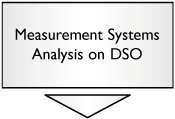 | Focus should just be on measuring validity; a sound operational definition and consistent measure of DSO versus a detailed investigation of Gage R&R should suffice. For more details see "MSAValidity" in Chapter 7, "Tools." | | 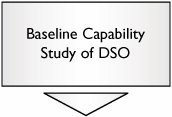 | The data is typically captured over a period of one week to one month (depending on process drumbeat) to get a reasonable estimate of Capability. Historical data will more than likely be sufficient for the purpose. |
After the baseline has been determined for DSO, the project will focus around two driving metrics: Timeliness, made up of (as a minimum) Accuracy, made up of (as a minimum)
| 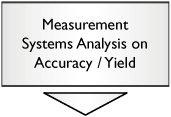 | In order to measure Payment Accuracy, first examine the validity of the measure. A sound operational definition and consistent measure of Payment Accuracy, versus a detailed investigation of Gage R&R, should suffice. | | 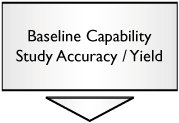 | Take a baseline Capability for Accuracy or Yield throughout the process from service delivered to payment received. This is Attribute data and so at least 150 to 200 data points will be needed to determine even an approximation here. For more details see "CapabilityAttribute" in Chapter 7. | |  | Construct a high-level Value Stream Map of the payment process, showing the high-level steps for the Primary Entity as it progresses through the process, from the time that the service is delivered to the time that the payment is received. This will also serve to determine good operational definitions of timing points for the subsequent Multi-Cycle Analysis. | |  | Apply a Multi-Cycle Analysis to the Value Stream Map to determine where the time is being spent, along with an indication of variation in times. Usually it is the variability in step times that causes the problems. It is important to note that, in the middlesection of the process when there is a wait for Suppliers to pay, they are legitimately allowed to withhold payment for an agreed length of time (known as "Terms"). This time should be dealt with separately from the rest of the timing calculations and hence needs to be broken out from the rest of the data. |
From both the Payment Timing and Accuracy data collected, the path can be selected from the following: | 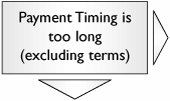 | If the overall payment time is too long from the Value Stream Map and the Multi-Cycle Analysis, the focus should be on reduction of the Payment Lead Time. Go to Section G in this chapter. | | 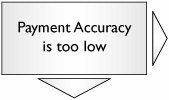 | If payments are being made incorrectly along the process, treat a Payment Inaccuracy as a defect and follow the defect reduction roadmap outlined in Section C of this chapter. | | 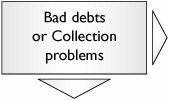 | For those cases where the problem lies externally, where Customers are failing to pay even within terms, Lean Sigma probably isn't the best roadmap. Some options include perhaps constructing a Pareto of the debt. It might be possible even to use Y=f(X1, X2,..., Xn) and follow the roadmap in Section C of this chapter with the Y being debt. This might have been done somewhere in the vast multitude of projects out there, but I've never come across it. | |  | For those cases where the payment terms seem to be too long, Lean Sigma probably isn't the best roadmap. This is a matter for your sales and legal groups to resolve with existing Customers and to set acceptable standards for all new Customers. This is outside the scope of this book. It is however useful to note that terms are often set based on the perceived value brought by the Supplier. It might be possible to streamline the delivery of entities to the downstream Customer and providethem additional value and thus improve the negotiating position. |
|









